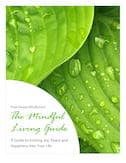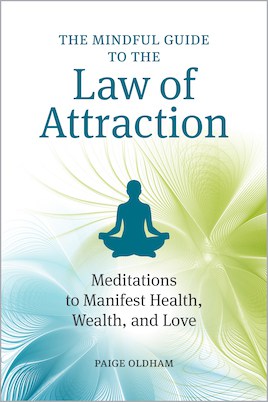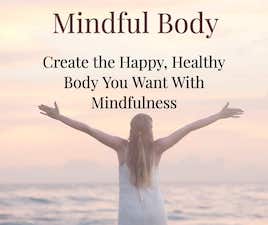We could all use more sleep. Most of us are pushed to keep going, going, going to produce more, more, more. Sleep is usually portrayed as some kind of necessary evil, to be reduced to as little time as possible.
While it’s “common knowledge” that we all need eight hours of sleep a night, there are plenty of articles and programs out there that will tell you that this is a myth and you really only need four or five hours. From my personal experience, that doesn’t work so well. I need seven or eight hours, but I know others who thrive with four or five.
Over time, I’ve applied mindfulness to the process to see what kind of impact I can make on my own sleep habits. The biggest lesson I’ve learned (which applies to just about everything in life) is that one size does not fit all. Even if you find your “size,” it doesn’t continue to fit over time. Things are always changing.
With that in mind, I’m going to cover some of the contributors to a better night’s sleep as seen through a mindful eye.
How Much Sleep Do I Need?
While the average of the bell curve of how much “everyone” needs is around eight hours, many aren’t at the peak of that bell curve. Some need much more and some much less. Environment, age, health, and other factors play a part in how much sleep you need.
Instead of beating yourself up for not getting eight hours of blissful, uninterrupted sleep (which might be possible for about 5% of the population), experiment with what feels right for you.
Hundreds of years ago, people weren’t writing about their sleep habits so we don’t really know how long people slept for. There are theories that people went to bed when the sun went down and woke at sunrise. That’s a long time to sleep, especially in the winter.
More research has been done that shows that pre-Industrial Revolution people slept in two shifts: going to bed just after darkness fell, waking for a couple hours around midnight and making pleasant use of the time, then going back to sleep until morning.
I sleep straight through the night about three nights a year. The rest of the time, I wake up sometime between midnight and 2am. Sometimes I can fall back to sleep and other times I can’t.
Ten or fifteen years ago, I used to set my alarm for 4am soI had time to do yoga, meditate and have some alone time. After a while, that toasted me, and I couldn’t sustain it, so I went back to getting up around 6am. Lately, I’ve been voluntarily waking up a little after 4am, unable to get back to sleep. Age, hormones and who knows what have changed my natural sleep habits.
Now I’m naturally up before 5am and ready for the day. As I get older, my environment changes (I’m no longer chasing young children around and tending to babies which takes tons of energy) so my sleep patterns are adjusting. I need to be mindful of these changes and not insist on being the same all the time (which can create a lot of self-induced stress).
Listen to your body. There are no “should’s.” There’s only what’s right for you here and now. And what’s right for you now will change over time. Every now and then, check in with yourself to see if your current habits are serving you. If they’re not, change them. Experiment.
Getting Ready for Bed
You’ve probably read about all the steps you can take to induce better sleep. But how many have you implemented into your daily sleep habits? Go through the following list and pick one new practice to implement tonight. Stick with it for at least one month to see how it works for you. Anything less won’t be long enough for you to feel an impact. Your body needs time to adjust to any changes.
After the first month, pick another practice to implement. Keep the first one you tried or drop it depending on how much it helped you.
1. Turn off all screens two hours before bedtime.
I know, I know. This one seems almost impossible for everyone. Whether it’s TV, computers, phones or whatever, everyone seems tied to a screen from the time our eyes open in the morning to the time they close at night.
Feeling that FOMO (fear of missing out) 24/7 keeps your brain wired and tired. It’s extremely unlikely that some bit of social media, email, text or whatever that will change your life will be missed if you shut off your devices a couple hours before bedtime (and while you sleep).
Take the opportunity to spend some focused, uninterrupted, quality time with your partner, kids or yourself. It will help to reduce your anxiety, depression, and general feelings of disconnection.
While most people sleep with their phone next to their bed to use it as an alarm clock or “just in case,” leave your phone out of the bedroom. Period. Charge it in your kitchen, office or living room.
There’s a very cool handmade product called Bagby that supports keeping your phone out of the bedroom. I’ve tried them and love them. Check them out here.
2. Make your bedroom as dark and quiet as possible.
It’s not rocket science that you need dark and quiet to sleep. Turn off the TV and phone (remember step 1?) and anything else that emits sounds. Turn off all the lights. Even a little night light can mess with your sleep.
If you live in a populated area, pull the curtains or blinds to keep out light from the streets. Depending on your existing curtains or blinds, you might want to invest in room-darkening curtains that are like what you see in hotels. They have a special layer that doesn’t allow any light through.
3. Avoid caffeine and alcohol before bed.
Depending on your sensitivity to these substances, you may need to cut them out sooner than some recommendations call for. Use mindfulness to notice how these things affect you.
Both are stimulants. While alcohol may help you relax initially, it converts to sugar in your body as it’s metabolized which causes you to wake up later on.
If I drink coffee after 1pm, it messes with me all night. My husband has a much higher tolerance. We’re exactly the opposite when it comes to alcohol. We both know how our bodies react to different things so, when we don’t follow what’s right for us, there’s no one to blame but ourselves.
4. Exercise during the day.
You don’t have to spend an hour at the gym or run for miles for exercise to help your sleep. Take a ten-minute walk in the middle of the day. I have a standing desk and a stationary stepper so I can “take a walk” while I’m working (that’s about the extent of my multi-tasking).
Spend some time gardening, playing with your kids or grandkids, walk to a friend’s house or coffee shop for a visit. Spend some time connecting with the people in your life who support you (without screens). This helps mind, body, and soul.
5. Have a regular bedtime.
Your body needs cues to anticipate when it’s time to shut down. Little kids thrive on this. So do adults.
Create a bedtime routine. Take a warm bath, sip some tea, meditate, journal, read a paper book. Do things you enjoy that help you relax and release the stress of the day.
If some worry is running around in your head, journal about it. Write out what you’ll do tomorrow to address it. Get it all out so it won’t keep you up at night.
To handle those thoughts that pop into your head in the middle of the night, I’ve found that a pad of paper and a pen with a blue light in it (like this one) next to the bed work wonders. When you think of something, write it down quickly while you’re still in bed without turning on the room lights. The blue light in the pen keeps your eyes in “night vision.” You don’t have to stay awake hoping you remember your bit of wisdom until the morning (which you won’t).
6. Make your bed as comfortable as possible.
This is something I’ve spent a lot of time on. Sheets, pillows, mattresses, blankets. They’re all very important parts of the equation. You spend about a third of your life in bed, make the investment in high-quality bedding. If you don’t, you’ll be paying for it during your waking hours with pains in your back, hips, and shoulders and general crankiness because you didn’t sleep well.
Many years ago, I researched “healthy beds” and found that most mattresses are filled with toxic chemicals. Who wants to sleep face down in a bed of carcinogens?
So I invested in an organic rubber mattress and wool-filled pillows from Lifekind. At the time, this was the only option for an organic bed (that I could find). It feels like memory foam without any bounce and offers plenty of support (almost a bit too hard since I’m a side-sleeper).
I would rather have purchased an organic innerspring mattress, but couldn’t find one back then. Things have changed and a company called Saatva answered my call. They have organic innerspring mattresses that are adjustable and made in the US of high-quality materials. They’re very reasonably priced given the high quality you get.
Saatva also has pillows and sheets that are completely organic. When my pillows and sheets arrived, it was like they were gift-wrapped just for me. The sheets (all organic) are super-soft, almost like Egyptian cotton. I love curling up in them at night (or for daytime naps).
The pillows are so-very-soft yet are firm enough to support my head (as I mentioned, I’m a side-sleeper). They don’t flatten out like the other wool pillows I had (which couldn’t be re-fluffed) and don’t immediately go flat like down pillows.
Combine all that with a great down comforter (make sure you get one with the “warmth” level that’s right for you) and you’ll never want to get out of bed.
If you’re sleeping on old, flat pillows or that bargain mattress that you bought ten years ago, give yourself the gift of a better night’s sleep for years to come by investing in better bedding. You’re worth it.
Which of these ideas will you implement tonight? And which will you implement next month? Take some time to reflect on how any changes, regardless of how subtle, affect you. Keep what works and drop what doesn’t. Keep experimenting. Everyone is different and will find unique sleep times and routines that work for them. Like I said earlier, there’s no “one size fits all.” Experiment to find your size and don’t judge what does or doesn’t work. That’s mindful sleeping.
Create the life you want: Combine the law of attraction with mindfulness
The law of attraction suggests that our positive or negative thoughts bring about positive or negative experiences. My latest book, The Mindful Guide to Law of Attraction, pairs that belief with the powerful practices of mindfulness. Through intentional breathing, writing, and engaging, you’ll hone a method for manifesting health, wealth, and love―the elements of happiness.
Let the law of attraction work for you by adopting its basic steps of identifying and visualizing the things you desire. Then use 45 practical meditation techniques included in the book to achieve awareness. By concentrating your positive energy on obtaining your wants, you’ll give yourself permission to receive them.
To your happiness! ~Paige

You can find this book at Amazon, Barnes & Noble, Books-A-Million, and Indigo.








 The Mindful Living Guide
The Mindful Living Guide




Great article, I try to sleep at least around 7-8 hours even though sometimes I just find myself sleeping less than 6 hours. I really have to look forward to your advice and get more sleep. Thanks for the information shared.
Thanks for these ideas, sleeping is good but working and hustling won’t make people sleep
A good sleep leads to the very energetic day. You won’t feel laziness in all your day. Thanks for sharing this wonderful tips, i also read about that the good sleep can also help in losing weight.
Great ideas! I tend to cycle through seasons of sleeping well and then not-so-well. Lately, I’ve been experiencing the not-so-well trend. I hadn’t thought about the toxins in mattresses and pillows though! I’ll have to look into that!
Thanks for this really useful post Paige!! My friend has recently been having trouble falling asleep at night due to work-related stress, have forwarded this to her. Please keep up the good work and I look forward to your next post!
“Sleep is usually portrayed as some kind of necessary evil”
This sentence is so true and in many cases is the cause behind low focus and unproductive waking hours with high stress and low productivity. Your guide is helpful and indeed everyone should experiment until they find the size that fits their needs.
Great guide!
I also sleep around 7-8 hours, although it happens that I sometimes only get 6 hours.
The funny thing is that sometimes I feel completely fine with 6 hours of sleep and other times I am destroyed haha. Not sure if it is because I interrupted a sleep cycle or because of other things.
Hi Paige,
I just wanted to say thank you for this post, it was very informative for me because as a child I had many problems with sleeping, later on it got better but recently I can’t sleep well and it’s getting on my nerves..
thanks again,
Kriszta